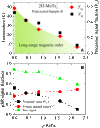Magnetism in semiconducting molybdenum dichalcogenides
- PMID: 30588488
- PMCID: PMC6303124
- DOI: 10.1126/sciadv.aat3672
Magnetism in semiconducting molybdenum dichalcogenides
Abstract
Transition metal dichalcogenides (TMDs) are interesting for understanding the fundamental physics of two-dimensional (2D) materials as well as for applications to many emerging technologies, including spin electronics. Here, we report the discovery of long-range magnetic order below T M = 40 and 100 K in bulk semiconducting TMDs 2H-MoTe2 and 2H-MoSe2, respectively, by means of muon spin rotation (μSR), scanning tunneling microscopy (STM), and density functional theory (DFT) calculations. The μSR measurements show the presence of large and homogeneous internal magnetic fields at low temperatures in both compounds indicative of long-range magnetic order. DFT calculations show that this magnetism is promoted by the presence of defects in the crystal. The STM measurements show that the vast majority of defects in these materials are metal vacancies and chalcogen-metal antisites, which are randomly distributed in the lattice at the subpercent level. DFT indicates that the antisite defects are magnetic with a magnetic moment in the range of 0.9 to 2.8 μB. Further, we find that the magnetic order stabilized in 2H-MoTe2 and 2H-MoSe2 is highly sensitive to hydrostatic pressure. These observations establish 2H-MoTe2 and 2H-MoSe2 as a new class of magnetic semiconductors and open a path to studying the interplay of 2D physics and magnetism in these interesting semiconductors.
Figures






References
-
- Soluyanov A. A., Gresch D., Wang Z., Wu Q., Troyer M., Dai X., Bernevig B. A., Type-II Weyl semimetals. Nature 527, 495–498 (2015). - PubMed
-
- Xu X., Yao W., Xiao D., Heinz T. F., Spin and pseudospins in layered transition metal dichalcogenides. Nat. Phys. 10, 343–350 (2014).
-
- Ali M. N., Xiong J., Flynn S., Tao J., Gibson Q. D., Schoop L. M., Liang T., Haldolaarachchige N., Hirschberger M., Ong N. P., Cava R. J., Large, non-saturating magnetoresistance in WTe2. Nature 514, 205–208 (2014). - PubMed
-
- Qi Y., Naumov P. G., Ali M. N., Rajamathi C. R., Schnelle W., Barkalov O., Hanfland M., Wu S.-C., Shekhar C., Sun Y., Süß V., Schmidt M., Schwarz U., Pippel E., Werner P., Hillebrand R., Förster T., Kampert E., Parkin S., Cava R. J., Felser C., Yan B., Medvedev S. A., Superconductivity in Weyl semimetal candidate MoTe2. Nat. Commun. 7, 11038 (2016). - PMC - PubMed
-
- Qian X., Liu J., Fu L., Li J., Quantum spin Hall effect in two-dimensional transition metal dichalcogenides. Science 346, 1344–1347 (2014). - PubMed
LinkOut - more resources
Full Text Sources
Research Materials

